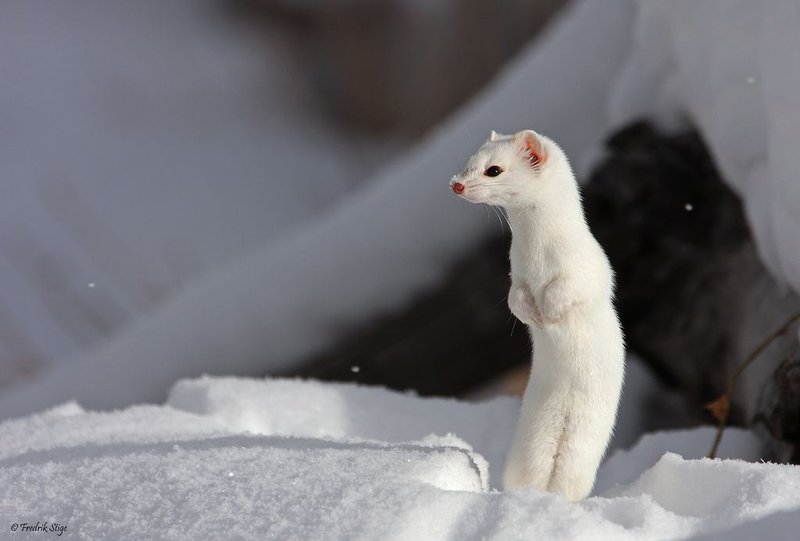
Let’s dive into the captivating world of the ermine. You might be wondering what makes this animal so special. Well, it’s not just about their adorable appearance. The ermine, also known as the short-tailed weasel, is full of surprises. From their fascinating hunting skills to their historical significance, there’s a lot to unpack. So, grab a cup of coffee, and let me share some of the most intriguing facts about this remarkable creature.
1. Unique Color Changing Ability
One of the most eye-catching features of the ermine is its ability to change color with the seasons. During the warmer months, these animals sport a rich brown coat. But as winter rolls in, they transform into a brilliant white. This color change is more than just style; it’s a clever survival tactic. The white coat helps them blend into the snowy landscapes, making it easier to sneak up on prey and avoid predators.
You might be interested to know that not all ermines turn completely white. In some regions, like parts of the northern United States, they retain a bit of brown on the tips of their tails. This dual-toned look offers an added layer of camouflage against the backdrop of mixed terrain.
2. Stellar Hunters
Ermines are small but mighty hunters. With their agile bodies and sharp senses, they are expert predators. They primarily feed on small mammals like mice, voles, and even rabbits. Imagine this: a tiny animal stalking its prey, moving almost silently through the snow. It’s a mix of stealth and speed, allowing them to pounce on unsuspecting critters with precision.
Their hunting skills aren’t just for show; they play a significant role in controlling the population of small rodents. By keeping these populations in check, ermines help maintain a balanced ecosystem. Talk about having a big impact in a tiny package!
3. Adaptable Habitats
Ermines are quite adaptable, thriving in various environments. You can find them in forests, grasslands, and even near agricultural fields. Their flexibility means they can make their homes in almost any area where they can hunt effectively.
They often create their dens in burrows or under rocks, which can be quite strategic. These hiding spots help protect them from larger predators and harsh weather. It’s like having your own little fortress in the wild!
4. Short Lifespan, Big Legacy
The average lifespan of an ermine is relatively short, usually around 2 to 4 years in the wild. But don’t let that discourage you; these little creatures pack a lot of life into a few short years. In the wild, they face numerous challenges, including predators, food scarcity, and harsh weather conditions.
Despite their fleeting lives, ermines have made a lasting impression on cultures worldwide. Their beautiful fur has been used in clothing and royal garments for centuries, making them symbols of luxury and status.
5. Social Behaviors
You might be surprised to learn that ermines are generally solitary animals. They prefer to roam alone, marking their territory and hunting independently. However, during the breeding season, they do come together, engaging in a courtship dance that’s quite fascinating.
Male ermines often perform elaborate displays to attract females. This can include vocalizations and playful behaviors, showcasing their fitness as potential mates. The bond formed during this time doesn’t last long, though; after mating, the males and females go back to their solitary lives.
6. Unique Reproductive Strategy
Speaking of mating, ermine reproduction comes with its own set of quirks. Female ermines are induced ovulators, meaning their ovulation is triggered by mating rather than occurring on a fixed schedule. After mating, the embryos can experience a phenomenon called delayed implantation. This means that the fertilized egg can stay dormant for several months before it actually begins to develop.
This strategy allows female ermines to time their births for the best possible conditions, ensuring that their young have the best chance for survival when they finally arrive.
7. Importance in Ecosystems
Ermines play a vital role in their ecosystems as both predators and prey. By controlling small mammal populations, they help keep ecosystems balanced. Their presence can indicate the health of an environment, serving as a barometer for biodiversity.
Interestingly, ermines themselves are preyed upon by larger birds of prey, foxes, and even domestic cats. This makes them part of the food web, linking various species together in the cycle of life.
8. Cultural Significance
Throughout history, the ermine has held a special place in human culture. Its soft, luxurious fur has been a symbol of wealth and nobility. In medieval Europe, for instance, ermine fur was often worn by royalty, especially in the form of capes and robes.
In art and literature, the ermine has been depicted as a symbol of purity and innocence, often associated with the Virgin Mary in Christian iconography. Its striking appearance has made it a favorite subject for artists throughout the ages.
9. Conservation Status
Currently, ermines are not considered endangered, but their populations can be affected by habitat destruction and climate change. As their environments shift, some populations may become isolated, leading to concerns about genetic diversity. Conservation efforts are important to protect their habitats and ensure these fascinating creatures continue to thrive.
Maintaining healthy ecosystems is essential for the survival of many species, including the ermine. By protecting their habitats, we indirectly support the multitude of life that depends on them.
10. Fun Facts to Wrap It Up
Here are a few fun tidbits about ermines that you might enjoy:
- Ermines can weigh between 1-3 pounds and measure about 10-12 inches long.
- They are incredibly fast, capable of running up to 10 miles per hour!
- Ermines have a high metabolism, which means they need to eat a lot to keep their energy up.
- In the wild, they might hunt up to 4-5 times a day, consuming a quarter of their body weight in food!
The more you learn about the ermine, the more you realize how complex and fascinating this creature truly is. From their clever survival tactics to their cultural significance, ermines are a reminder of the beauty and intricacies of nature.
Whether you’re an animal enthusiast or just curious about the world, I hope this dive into the life of the ermine has sparked your interest. These small animals, with their big personality, deserve a spot in our hearts and on our conservation lists. So the next time you see this little furball in the wild or on screen, remember all the incredible facts you now know!

